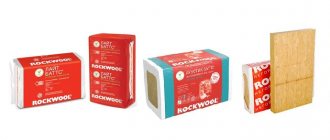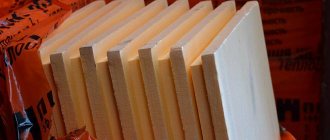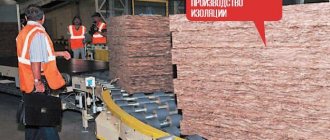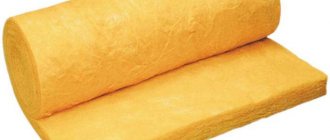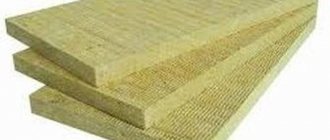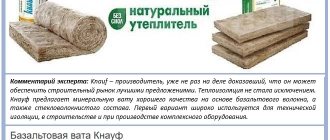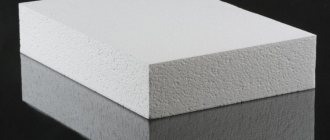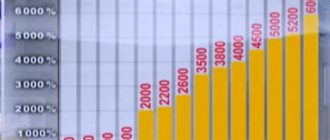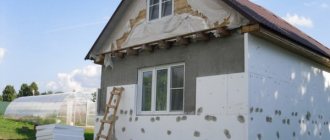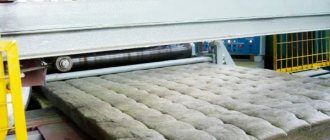What is Knauf Cottage
The insulation is produced in the form of compact slabs
Knauf Cottage insulation belongs to the category of non-flammable elastic insulation, has optimal water-repellent qualities and is recommended as insulation for walls and pitched roofs. The material is produced in the form of compact slabs with a convenient density and thickness of 50 or 100 mm, which makes it possible to select it taking into account the size of the structures in a particular room.
Installation using slabs from the Knauf Cottage series does not cause difficulties even if you have no experience. The shape of the slabs allows them to be installed over several approaches, and insulation of walls or roofs in a single layer without the formation of cracks and joints. The material is easily cut and adjusted to the required dimensions, which ultimately saves time spent on installation. In addition to thermal insulation, the slabs have ideal sound-absorbing properties and are a universal building material.
Advantages and disadvantages
Knauf Acoustic sound insulation, like any building material, has its advantages and disadvantages. If we talk about the advantages of the material, there are a lot of them, and they are as follows:
- Non-flammable material belonging to the “NG” group. Such characteristics allow the use of insulating boards in areas with increased fire hazard.
- The durability of the product makes it possible to use insulation boards for at least fifty years, while they do not lose their properties and characteristics.
- Due to the fibrous base of the panel, rodents, insects, fungi and mold are not afraid of. Such indicators make it possible to use insulating material under conditions of high humidity.
- The stove does not contain harmful components that have an unpleasant odor, so they can be used even in rooms for allergy sufferers and children.
- During the process of working with slabs, cutting and installation, a lot of dust does not form, which causes less clogging of the room being processed and saves time on cleaning.
- The soft base does not cause discomfort during installation of soundproofing. The elastic base easily returns the original shape of the slab structure.
- The product contains natural ingredients. The adhesive base consists of wood resins that do not have a negative effect on human health and well-being.
- Affordable cost of slabs. Compared to analog materials, the cost of acoustic kunaf sound insulation is suitable for an average family with an average income. Using such sound insulation you can not only effectively protect your home from noise, but also spend a minimal amount of time and money on it, which is important.
@Knauf
Despite all the positive qualities of acoustic Knauf sound insulation, there is one minor drawback: during installation it is necessary to create a profile frame. This sound insulation takes up space in the room. To be more precise, on average the thickness of the insulation will vary around ten centimeters. Considering that the distance will be removed from each wall, the area of the room being treated will decrease somewhat. The insulating material simply has no other disadvantages, which explains its popularity among buyers.
Advantages of insulation
The advantage of insulation is its good biological resistance and natural composition
TeploKnauf Cottage insulation is produced by the company of the same name in Germany, which has a proven reputation as a reliable manufacturer of building materials. This convenient board material belongs to the premium class, is made from substances of natural origin that do not provoke allergic reactions, and is completely safe for health. It reliably retains heat inside the space and has an optimal level of noise suppression, is resistant to fire and meets fire safety requirements.
The list of main advantages of insulation includes:
- good biological resistance - the material is not susceptible to insects and rodents;
- comfortable texture, absence of synthetic odors, ease of work;
- longest service life;
- ability to shrink in size for more comfortable movement;
- minimum shrinkage and load on the walls;
- warranty from the company for more than forty years;
- natural composition, excluding the presence of dyes, bleaches and other substances.
High-quality insulation helps save money on heating a room in winter due to its low level of thermal conductivity compared to standard brick.
About the advantages of Knauf insulation
1. The thermal conductivity coefficient is very small. Thanks to this quality, in winter, when frosts are especially severe, it is possible to maintain a favorable temperature in the apartment.
2. Sound absorption level is high. Therefore, KNAUF mineral wool is good to use for sound insulation. This will be especially appreciated by those whose houses are located next to a tram depot, railway or busy highway. Finally, the long-awaited silence will reign in their apartments.
3. Fire resistance is good. According to the fire resistance class, this insulation belongs to non-combustible materials (designated NG). This is great - after all, no one is immune from accidents, no matter how careful you are.
4. Biostability – at a high level. Mineral fibers are too tough for rodents. For people living in their own home, this is simply a salvation. After all, rats and mice nestling comfortably in a layer of insulation are by no means a homeowner’s dream.
5. Knauf insulation materials do not emit any unpleasant odors. In fact, they don't smell like anything at all. They are also soft and non-prickly. Working with such material is a pleasure.
6. Transporting this mineral wool is convenient and easy. It can be compressed well, taking up very little space. And when you arrive at your destination, you can quickly straighten it out. Moreover, the shape and size will not change at all.
7. This heat insulator weighs very little, and even after a long time it does not shrink at all.
8. The insulation is installed extremely simply, and lasts for at least half a century. This guarantee is given by the manufacturer - and you can trust him.
9. Proper thermal insulation using this mineral wool makes it possible to reduce costs during the heating season by half.
10. The manufacturer does not use any dyes or bleaches in the production of this material. The pleasant brownish color makes KNAUF mineral wool easy to recognize.
Well, does Knauf insulation have any disadvantages? There is one drawback - it is expensive, unfortunately, and not everyone can afford such a pleasure. In addition, Knauf insulation is fiberglass, with all the disadvantages that are inherent in this type of insulation, see the article for more details: Technical characteristics of mineral wool, its brand and selection criteria.
Features of Knauf products
Knauf is a manufacturer of building materials with a long and rich history. The German company has been operating for at least 70 years, and that's only at the global level. And locally it operates over an even longer time frame.
Knauf specialists really know how to create building materials. They are engaged in the production of building mixtures, mortars, facing materials and insulation.
Knauf pays a lot of attention to insulation. Although she concentrates on just one area. And this sphere is mineral wool. Why stone mineral wool?
Yes, because its technical characteristics are the best. It is quite easy to work with, it is moderately expensive, but at the same time extremely effective.
Such a clear concentration over the years could not help but leave certain marks on the company's style. Modern Knauf basalt wool has truly unique technical characteristics. By the way, glass wool and mineral wool are essentially the same thing.
Many of the techniques used in it were only adopted by other manufacturers many years later. Such as, for example, the elasticity of the plates and the possibility of packing them in large quantities, due to possible temporary deformations.
In the end, Knauf products are simply very high-quality and reliable mineral wool, the reviews of which are overwhelmingly positive. And since almost all reviews about it from customers have no complaints at their core, then this material is really worth paying attention to.
Production nuances
Stone wool is so called because it is made from stones. No matter how funny it may sound, it is true. Its second name is basalt wool. It’s already more clear here.
Basalt mineral rock is used in production. Lava stones are melted down, then a binder and several chemical elements are added to them and knitted into fibers.
The finished fibers form solid slabs or rolls as we know them. However, mineral wool can be produced using different technologies and using different materials.
Structure of Insulation mineral wool slabs
It is the production process that influences what technical characteristics mineral and basalt wool will have in the end.
Ordinary mineral wool, although quite good, can be harmful, generate dust and is afraid of moisture. The guys from Knauf managed to overcome all these troubles, which allowed them to create an almost perfect insulation.
During the formation of cotton wool fibers, they completely abandoned the use of phenolic and formaldehyde resins. Almost all reviews about the dangers of mineral wool were directed at the fact that when heated, it can emit these same phenol vapors, which, in fact, are quite toxic.
There are no harmful resins in Knauf mineral wool, which means there are no harmful fumes.
The same applies to the ability of the insulation to emit dust. Dust harms human lungs and irritates the skin. Most often, it is not mineral wool that generates dust, but glass wool, but poorly formed mineral wool fibers can also break, which leads to the release of dust.
Knauf basalt wool is made of very high quality, so you won’t feel any dust when working with it. You won't need additional protection either.
As for water absorption, mineral wool slabs and rolls have been haunted by these negative characteristics for many years. The issue was resolved by adding special water repellents during the knitting process, substances that help repel water from the material.
As a result, this problem was solved by Knauf specialists. Actually, this is why reviews about Knauf mineral wool slabs consist almost entirely of positive comments.
By the way, basalt wool is not harmful to health.
Characteristics of mineral wool
The characteristics of mineral wool slabs from the Knauf company are not satisfactory. Basalt wool itself is very good.
It easily withstands temperature changes, does not burn in fire at all and is not permanently deformed.
Its thermal conductivity is at the level of 0.035-0.4 W/m, which indicates an extremely low heat transfer coefficient.
In fact, cotton wool does not transfer heat at all. It cannot cope except with thermal radiation, but there are other insulation materials for that, which, by the way, can also be combined with this material.
However, Knauf specialists were able to achieve impressive results here too.
You can work with Knauf mineral wool without protection
For example, Knauf mineral wool, if you look at its characteristics in terms of water absorption, has extremely low performance. They are at the level of 1-2% of the total volume.
If we translate this into simple language, then after the entire surface of the slab is lowered into water, in a few days it will absorb at most a few percent of the liquid, in comparison with the total volume of the slab.
This is a completely insignificant indicator. In fact, Knauf mineral wool is on a par with polystyrene foam in terms of hydrophobicity. At the same time, it remains vapor permeable.
Knauf basalt wool does not burn in fire and does not even heat up. At most, it can char, but only in the place of direct contact with fire and only if there is a very high temperature there.
As for density indicators, they are very different here. The fact is that there are several lines of branded insulation. There is Teploknauf mineral wool, Insulation with sawdust as insulation, etc. Moreover, each line has several more models of individual insulation materials.
And each of them is intended for its own purposes. Some insulate walls, others insulate pitched roofs, and accordingly their density and weight will differ, and very seriously.
Types of Knauf insulation
So, as we have already said, Knauf mineral wool thermal insulation materials are divided into two subgroups or lines:
- Insulation;
- Teploknauf.
Each is intended for its own tasks and was developed specifically for their implementation.
The Insulation range is known for its exceptional quality. This is rather a professional, rather expensive, almost universal type of insulation. It is very convenient to lay it on a large scale when multiple areas need to be processed.
In addition, the Insulation line offers excellent performance and extreme durability. Mineral wool Insulation insulates a house for decades. Moreover, the manufacturer himself provides a minimum 40-year warranty.
Basalt wool Teploknauf in rolls
But this does not mean that in 40 years there will be nothing left of the slab. Most likely, it will serve you for quite a long time, provided, of course, that the Insulation wool has been used under normal conditions.
But the Teploknauf line is a simpler insulation. So to speak, a household option. With its help you can decorate a small cottage, country house, etc.
Knauf Insulation
The Insulation line, in turn, is divided into 4 more subtypes. In fact, they are exactly what are used in the work.
So, as part of insulation from the Insulation group, Knauf mineral wool is distinguished:
- Heat Roll;
- Heat Stove;
- Acoustic partition;
- Pitched roof.
Heat Roll are high quality mineral wool rolls. Since it is convenient to work with rolls only in certain situations, they are used mainly for finishing floors or attics.
Heat slabs are already mineral wool slabs. Plates are more versatile. They can be mounted in any convenient place. Unless you need to be careful with the roof.
The Acoustic sample or Acoustic partition, as is already clear from the name, is intended for arranging sound insulation. In fact, any mineral wool insulation in itself does a good job of dampening noise loads, but this type of thermal insulation was specially created to absorb all sounds.
The last option is intended for insulating roofs between the rafters. It is the lightest and airiest from the Insulation line. The slabs are very elastic, they can be deformed and compressed by almost 40%, which allows them to be safely laid in frames of any size.
Teploknauf
Wall insulation using frame technology with Knauf mineral wool
The Cottage and Cottage+ models are the most expensive and high quality. In fact, that’s why the word “cottage” is in their name. With their help, the walls, roofs, ceilings and floors of the house are insulated. Any cottage can be finished with this insulation quickly and easily.
The Dom and Dom+ samples are more focused on finishing pitched roofs and protecting light structures. For example, for insulating attic walls.
Well, the Dacha model is the cheapest of the insulation materials. Designed for use in cheap country houses where it makes sense to save on materials.
How to insulate a roof
For insulation, it is effective to use Knauf thermal insulation material, which is laid in accordance with the manufacturer’s requirements. Since heat loss through the roof can be very large and noticeable, to prevent it it is necessary to create a reliable thermal insulation layer.
Thermal insulation can be ventilated or unventilated; in the first case, conditions for condensation are not created, and the roof can “breathe,” which has a positive effect on the microclimate in the room directly under the roof. Knauf insulation is available for installation on pitched and level roofs; it is produced in several varieties for different types of walls and roofs, differing in the thickness and size of the slabs.
Before insulating the roof, you need to choose a high-quality and optimally suitable thermal insulation material, one of which is Knauf insulation, presented in the assortment of the Construction Warehouse online store.
Technical characteristics: "Teploknauf" for roofing
This material is a professional insulation material that comes in the form of rolls. The thickness is 150 mm. Thermal insulation is characterized by an enhanced water-repellent effect. It is specially designed for pitched roofs.
“Teploknauf” roof insulation has an elastic structure that allows it to fill the space under the roof. This material is comfortable to use and safe, as it does not contain acrylic resins or phenol-formaldehyde. Made using water-repellent impregnation.
The slabs cut well, are easy to install by surprise, and are not flammable. If you are interested in Teploknauf insulation, you should definitely consider the technical characteristics of this material. As for thermal insulation for roofing, it is presented in another variety - “For ROOF+”. In this case, the thickness is 150 mm, while the length and width are 5500 and 1220 mm, respectively.
The volume in one package is 1 m3. The packaged area is 6.71 m2. This material is not flammable, like “Teploknauf for roofing”. The latter variety has a thickness of 50 mm, while the length and width are 6148 and 1220 mm, respectively. The package volume is 0.75 m3, while the area of the material in the package is equivalent to 15 m2.
The materials described are durable; they can last more than 50 years. The materials do not have an unpleasant odor, are resistant to adverse conditions and perform their functions perfectly even if errors were made during installation. Teploknauf insulation is resistant to insects and rodents.
Technical characteristics: “Cottage” and “Cottage Plus”
As practice shows, “Cottage” is the most innovative and warm solution for houses whose owners choose the best options, but are not used to overpaying. The material is fireproof, highly elastic, and is created using “three-in-one” technology.
“Teploknauf Cottage” insulation, the characteristics of which will be presented below, is suitable for protecting a home from noise and cold. The material has excellent water-repellent characteristics. This type of thermal insulation can also be used to insulate pitched roofs. The material is excellent for soundproofing rooms.
Depending on your preferences, you can choose thermal insulation in the form of rolls or slabs. "Cottage Plus" is a 100 mm insulation, which is cheaper than two layers of 50 mm. Labor costs during installation and cutting of material are reduced, and less scraps and debris are generated during the work.
Thanks to increased elasticity, the fastening in the structure is more reliable. This is also due to the solid structure of the material. As practice shows, the thickness of building structure elements is usually a multiple of 100 mm.
The described insulation “Teploknauf” for roofs and walls in slabs has the following parameters: 1230x610x50 mm. The volume of material in the package is 0.6 m3. As for the area of the package, it is 12 m2. There are 16 slabs in a package. As for the rolled “Cottage”, its length, width and thickness are 6148x1220x50 mm, respectively. The volume of material in the package is 0.75 m3, while the area is 15 m2. There are 2 rolls in the package.
Specifications
Technical characteristics of the insulation
The slabs are produced in the following versions: TeploKnauf Cottage and TeploKnauf Cottage+ with a factory thickness of 50 and 100 mm, respectively. The dimensions of standard slabs are 1230x610 mm, in rolls 6148x1220 mm, which makes it possible to use the first option for thermal insulation of houses in the Southern and Central regions, the second for Siberia and the Northern territories. The versatility of the material and compliance with a high class of reliability makes it possible to use it for complex insulation of structures of summer houses and private houses, as well as sound insulation in partitions between rooms.
The technical parameters of the slabs include the optimal thermal conductivity value of 0.037; an acceptable level of noise insulation with an index of 45. The material is non-flammable and is highly resistant to fire. The volume of slabs in rolls and packaging is 0.75 m3, the area is 15 m2, each package contains 20 pieces of slabs and 2 rolls. The insulation goes well with other building materials of the brand, for example, TechnoNIKOL and Technofas Cottage mineral wool slabs.
TeploKnauf Cottage + is not sold in rolls; it is sold mainly in the form of slabs, which are installed much faster compared to material with a thickness of 50 mm.
"Teploknauf Dom" and "House Plus"
Insulation "House Teploknauf" is a comfortable-to-use slab that is used to insulate floors and walls. Thermal insulation is created using the 3D elasticity technology, which is popular today and has already proven itself. The material adheres well to the structural elements and eliminates the formation of cold bridges.
“Teploknauf Dom +” insulation is a 100 mm material that has many advantages. For the same area, it is cheaper than two layers of 50 mm each. During installation and cutting, labor costs are reduced, and fewer scraps and debris are generated. Thanks to the solid structure, the material is more securely attached to the structure.
Technical characteristics: “Teploknauf Dom” and “Dom Plus”
Taking a closer look at the “Teploknauf House”, you can understand that its length, width and thickness are 1230 x 610 x 50 mm, respectively. One package contains 0.6 m3 of material. As for the thermal insulation area, it is limited to 12 m2 in one package. There are 16 canvases in one package.
This material is also non-flammable, like Dom Plus. The Teploknauf Dom Plus insulation has the following parameters: 1230 x 610 x 100 mm. The volume of material remains the same, but the area decreases and becomes equal to 6 m2. There are 8 canvases in one package.
Dimensions and Application
This type of Knauf sound insulation, Acoustic, is produced in the form of slabs with dimensions of 50x610x1250 mm, where 50 mm is the thickness, 610 is the width, 1250 is the length of the product. One package contains 16 such panels, the volume of which is 0.6 m³. This amount is enough to cover a surface area of 12 m². One pallet holds 32 packages, each of which weighs 9 kg.
The material is also supplied to stores in the form of rolls measuring 7.5 x 0.61 m. To work with Knauf acoustic wool, you do not need special tools or professional equipment. Installation of mats is similar to the process of installing mineral and basalt wool. The installation of Acoustic Knauf is carried out in such a way that not a single extra piece remains after it. When a frame for a wall or partition is built during construction, a distance of 60 cm is left between the load-bearing parts. This width is quite enough to accommodate the Acoustic Knauf panel.
We recommend: Review of popular soundproofing materials for walls
The range of use of Knauf Acoustic acoustic tiles is wide. This material is an excellent decoration for interior spaces of any type:
- living rooms;
- apartments;
- private houses;
- offices;
- commercial buildings.
Knauf sound insulation is suitable for ceilings, walls and even floors. The main thing is to choose the optimal coating option and lay the material as indicated in the instructions. Mats of this brand require that the partitions or box frames against the wall be insulated from vibration. The fact is that in the absence of insulating tape in the form of a lining layer, vibration resonance will cause loud noise.
Knauf Acoustic sound insulation does not contain phenol-formaldehyde compounds or chemical mixtures. This allows you to successfully use it when finishing such premises as:
- kindergartens;
- orphanages;
- hospitals;
- clinics;
- maternity hospital;
- schools.
And thanks to its thermal insulation qualities, the material is used to equip warehouses and production workshops.
Knauf Acoustic sound insulation is a non-flammable material, so it is popular when finishing explosive premises such as fuel and lubricants warehouses, flammable liquids.
Quality and comfort - this is Knauf insulation
Knauf insulation is only natural mineral wool without the addition of resins. It is insulation materials made from natural mineral bases that are extremely popular in many places. Therefore, the Knauf company was not at a loss and began to produce such insulation. Today there is a wide range of Knauf mineral-based insulation materials. In addition, the company also offers to purchase thermal insulation mats and slabs. And remember that the base should include only natural mineral wool.
It is generally accepted that Knauf mineral wool insulation materials have the following advantages:
- Safety;
- Durability;
- Quality;
- Efficiency;
- Environmentally friendly.
These advantages are obtained through the use of high modern technologies. The Knauf company uses innovative methods for the production of thermal insulation materials. These same technologies make it possible to achieve high efficiency of the material and complete safety during use. Using Knauf thermal insulation, people will definitely begin to save on both heating and air conditioning. We wrote this not because we wanted to, but because people who have used it say so. Among other things, insulation and other materials are tested in special laboratories , where these confirmations were obtained.
The main technology used in the manufacture of insulation is ECOSE. Thanks to this technology, mineral-based insulation does not contain harmful components. For example, you will never find substances such as formaldehyde in its composition.
So, let's summarize. Knauf insulation ideally keeps the house warm, but at the same time air circulates unhindered. Therefore, it will not be cold in winter and not hot in summer. Also known now ECOSE technology is a unique production and a guarantee that the insulation truly consists only of mineral binders. According to known data, when using Knauf thermal insulation, people do not have to worry about their safety and environmental friendliness of the product.
Insulation of attic roof
To reduce heat loss in the house, and therefore save on additional heating costs, homeowners insulate roofs and attics, improving heat-saving properties.
The use of Knauf insulation is an effective way to achieve the desired result. It has low thermal conductivity, resistance to moisture, is able to retain its shape, as it has optimal density, and has good noise insulation properties. Thermal insulation material from a German manufacturer is environmentally friendly, which is extremely important when used on the surface of attic spaces, which are especially susceptible to temperature fluctuations and weather influences, so that no toxic harmful substances are released when exposed to high temperatures.
KNAUF INSULATION thermal plate 037
KNAUF INSULATION Thermal plate 037 is a material made from natural mineral wool, created in the form of slabs. These insulation materials are used both in construction and renovation. Its main feature is that it has high sound-absorbing properties.
KNAUF INSULATION THERMAL PLATE 037 in use
Main properties of KNAUF INSULATION THERMOPLATE 037:
- vapor tightness;
- convenient standard size;
- elasticity;
- elasticity.
The thermal plate combines low weight and high thermal insulation, so choosing the desired thickness of the material is not difficult. A suitable thickness will reduce the load on the main frame. Another important plus of this thermal insulation is that even after decades, the material will not lose its original appearance and will continue to keep the house warm.
Application:
- interfloor ceilings;
- base in the form of insulation for siding;
- partitions;
- attic coverings;
- insulation of floors.
Insulation “TEPLOKNAUF COTTAGE” & “TEPLOKNAUF COTTAGE+”
Insulation “TEPLOKNAUF COTTAGE” & “TEPLOKNAUF COTTAGE+” are also insulation materials based on natural mineral wool and modern high technologies. This type of insulation is suitable for that category of people who want to bring warmth and comfort into their home without extra costs. Like other thermal insulations, the material “TEPLOKNAUF COTTAGE” & “TEPLOKNAUF COTTAGE +” is non-flammable, but at the same time it contains 3in1 technology. 3in1 implies that this insulation will retain heat, prevent the penetration of sounds, and it also has water-repellent properties .
Application of insulation materials “TEPLOKNAUF COTTAGE” & “TEPLOKNAUF COTTAGE+”:
- roof;
- walls.
Types of insulation materials “TEPLOKNAUF COTTAGE” & “TEPLOKNAUF COTTAGE+”:
- rolls;
- slabs
TEPLOKNAUF COTTAGE+ is a unique, completely new type of thermal insulation. Its thickness is 10 cm. What contributes to:
- Savings (it is better to use this insulation, 10 cm thick, than another and lay it in 2 layers of 5 cm each).
- The smallest amount of waste generated.
- Less labor costs.
- Reliable fastening in the structure.
- Other building materials are of a similar thickness.
Professional thermal insulation Knauf
For serious projects, the company produces a separate line of Knauf Insulation. It appeared on the market a little earlier, so there are already a lot of positive reviews about it. Main types:
- Knauf Thermo Plate 037 is a universal insulation material that can be used both to protect building envelopes and in ceilings for any purpose. Mineral wool with similar characteristics is also available in the Knauf Pitched Roof series; we will describe it below in this review.
- Knauf Thermo Roll 040 - used for insulating interior partitions, attic floors and pitched roofs. However, it is necessary to ensure that the mineral wool does not experience compressive loads - after all, its density is low (11 kg/m3). Available only in thickness 50 mm with canvas dimensions of 1.2x10 m.
- Knauf Acoustic (partition) - found both in the form of slabs 61x125 cm, and in the form of rolls 7.5x0.61 m with a thickness of 50 mm. It differs from other Knauf Insulation insulation by the increased elasticity of thin and long wool fibers, as well as by higher sound insulation rates. However, Acoustic is not intended for enclosing structures; its main area of application is internal partitions and interfloor ceilings. Noise absorption at minimum thickness is about 57 dB.
Knauf mineral wool for pitched roofs is represented by a whole family of insulation materials. For roof rafter systems with a large slope and attic superstructures, you can buy more rigid slabs; for attic floors and flat surfaces, it is more convenient to use soft rolls, laying them on a solid base.
Knauf Insulation Pitched roofing:
- ThermoRoll 034 and 037A differ from each other only in thermal conductivity indicators, which are determined by the index in the product name. The release form of mats 034 is 1.2x5 m with a thickness of 50 mm. Knauf 037 has a slightly wider selection: here you can purchase 150 mm rolls and thin products with a web length of 9 m.
- Mineral wool ThermoPlate 034 and 037A - in terms of characteristics, everything is quite standard (0.034 and 0.037 W/m K). The dimensions of Knauf slabs 1250x610 mm with a thickness of 50 mm do not seem convenient to everyone, and there are often reviews where builders complain that thin mats fall out of the rafters. But Knauf ThermoPlates 100 mm do not have this drawback.
Despite the unambiguous name of the series, Knauf Insulation mineral wool is used not only for pitched roofs, but also for insulating attic floors along joists. In any case, you should not allow loads to be applied to the insulation layer.
Facade insulation is produced only in rigid mat format and has improved energy-saving characteristics. In addition, Knauf Insulation ThermoPlate 032 has a higher degree of moisture protection and absorbs up to 0.6% of water from its volume when partially immersed. For products with index 034, the same figure is 0.8%. At the same time, the density of Knauf 032 slabs is noticeably lower (25 kg/m3 versus 34). But the size of the mats is the same for the entire series: 1.25x0.6 m.
Knauf insulation reviews
Good insulation option.
I finally started making my long-time dreams of building my own home a reality. I decided to build the house using frame technology, the house itself is made of wood, and the insulation was chosen TEPLOKNAUF COTTAGE. Upon completion of construction, we can say with confidence that this insulation came in handy. This is the best option I've ever worked with. I was pleased with the fact that the house remained warm.
Of course, we must not forget about the installation rules and recommendations . That's when everything will work out in the best possible way. I was also convinced of a lot of other positive qualities. Firstly, I didn’t have to bother strangers; I did almost everything myself. Secondly, I was impressed by the fact that it is rigid and bends well, while also being lightweight. One point: I advise you to carry out all installation work wearing special gloves. TEPLOKNAUF COTTAGE allows steam to pass through well, which means there will be no moisture formations in it. As a result, we can say that this is worthwhile material and there is much more positive in it. Definitely suitable for a frame house. And I wasn’t even stingy with my review.
Advantages: inexpensive, practical and lightweight .
Disadvantages: Prickly to the touch.
Andrey Vorobiev
Knauf Cottage insulation is an alternative to expensive analogues.
I recently purchased this insulation at a reasonable price . It is necessary for insulating partitions on profiles. I was amazed that this is a fairly affordable option. Compared to other expensive insulation materials, Knauf is not very dense, but it worked quite well as an interior decoration.
It fits 5 cm between the posts and probably won’t slide down. Of course, sound insulation is excellent. I recommend using it for interior decoration or as sound insulation. For external work, it is advisable to look for something else. For sound insulation, you don’t need to spend money on expensive manufacturers - Knauf Cottage insulation is good in this case. It is very easy to cut, has a slight thorniness, but your hands do not itch like insulation from the Parok or Rockwool brands. also recommend working with gloves . I consider my review to be the most objective.
Advantages: affordable, no itching after use, excellent soundproofing qualities.
Disadvantages: Low density, therefore not suitable for exterior decoration.
Yaroslav Grigorievich
Knauf Cottage for insulating a summer kitchen
I gave my parents a gift - I insulated the summer kitchen . The people are elderly, the house is small, but there are many relatives. Especially often, all the grandchildren and children come in the summer season. So we decided to make the meeting place more comfortable so that everyone could enjoy the cooking and drink tea.
For this case, we chose Knauf Cottage insulation. It seemed to us that German quality should justify itself. Moreover, this brand is often advertised in the media, which means it has some popularity. It consists of natural mineral wool or popularly known glass wool. The predominant color is light brown, almost sandy. I was pleased that, unlike its predecessors, glass wool is non-prickly and soft. And also does not take up much space during transportation. Roll it up and that's it. What can I say, a good and high quality thing. As they say, “it doesn’t burn in fire, it doesn’t drown in water.” This can probably be safely attributed to her. In addition, the service life is inspiring .
Advantages: retains heat, does not burn.
Disadvantages: the price is high for older people.
Knauf insulation
Knauf insulation is a whole series of mineral wool materials created for thermal and sound insulation of floors, walls, roofs, ceilings, facades of residential and non-residential buildings. The products of the German company are made from natural ingredients and have good insulating properties. You can distinguish the products of this brand from other such materials by their color - since neither bleaches nor dyes are used in its production, Knauf insulation has a natural light brown color. Why do you need to insulate your house?
Insulating a house is a separate stage of construction, requiring both time and money. Why do you need to insulate a building at all? Firstly, high-quality insulation of the house will allow you to maintain a comfortable temperature and microclimate in the room, and secondly, due to it you can significantly save on utility bills. If a house is poorly insulated, then heat escapes from it into the environment around it, and it turns out that most of the energy is spent on heating not the house itself, but the street around it. But in a well-insulated building, heat loss is minimized, due to which heating costs are significantly reduced - up to 45%. Thus, the cost of installing thermal insulation is soon recouped by reducing heating or energy costs.
Advantages of Knauf insulation
- Low thermal conductivity. Knauf insulating materials practically do not release heat from the room and at the same time do not create a “greenhouse” effect in it, allowing the building to breathe and maintaining a comfortable microclimate in it. Therefore, in cold winters such a room will be warm, and in hot summers it will be cool.
- Fire safety and fire resistance. Knauf mineral wool belongs to the class of non-combustible materials; it does not contribute to smoke and does not spread fire.
- High level of sound absorption. Thermal insulation made of mineral wool, due to its porous structure, perfectly absorbs noise, so it can also be used as sound insulation.
- Natural composition. The entire line of Knauf insulation products is made from completely natural materials without the use of petroleum products, so it is completely safe for both humans and the environment. Typically, such materials use phenol-formaldehyde resin as a binding component, the production of which has a negative impact on the environment. However, Knauf abandoned its use and replaced it with an absolutely natural binder developed by the company.
- Moisture resistance. Mineral wool materials are not susceptible to moisture and dampness due to their dense structure, so they effectively resist the formation of fungus and mold.
- Long service life. The materials retain their thermal insulation properties for at least 50 years - this is the period for which the manufacturer guarantees them.
- Protection from insects and rodents. The insulation is resistant to rodents and insects - they simply will not be able to chew through the mineral wool layer, so your home will be reliably protected from pests.
Among the disadvantages of Knauf insulation is their high cost, however, subject to high-quality installation, it will pay off by reducing the cost of heating and heating the house.
Product lines
Materials produced by Knauf are supplied both in the form of tightly rolled rolls, easy to transport, and in the form of slabs. All types of insulation are easy to use - they are easy to cut, do not generate dust or leave behind construction debris, have a non-scratch surface, and do not have the unpleasant odor inherent in other types of mineral wool materials. There are several types of insulation depending on the scope of their use - let's look at each of them in more detail.
HeatKnauf
The TeploKnauf line is intended for private construction. It includes insulation materials for roofs, floors, walls and interior partitions, as well as roll sound insulation. The series includes three main types of products, which differ mainly in thickness and level of thermal insulation.
- "Country house". These are materials with the smallest thickness (50 mm), intended for rooms that are used only in the warm season. This type is supplied only in rolls and has dimensions of 1220*7380 mm.
- "House". This insulation has a large thickness (from 50 to 100 mm) and dimensions from 610 * 1230 mm to 1220 * 6148 mm, and also has an average level of thermal insulation, making it suitable for use in private homes.
- “Cottage” has the lowest thermal conductivity and is therefore intended for insulating houses where people live all year round. Products of this type are supplied both in the form of slabs (thickness 50 or 100 mm, size 610 * 1230 mm) and in the form of rolls (thickness 50 mm, size 1220 * 6148 mm).
Insulation
Another line is called “Insulation” and is intended for those who are professionally involved in construction. This series offers an even larger range of insulation materials with different characteristics. All of these products can be used as sound insulation.
- “Thermo Plate” is a universal material with an almost unlimited scope of application - it can be used to insulate walls, roofs, ceilings, floors and so on. This type has the shape of a slab with a thickness of 50 to 100 mm and parameters of 600 * 1250 mm.
- "Thermo Roll" is mainly used for laying on flat surfaces with low load - for example, on roofs, attic floors or ceilings. This type is usually rolled and is longer than other types - 10,000 mm - with a width of 1200 mm and a standard thickness of 5 cm.
- “Pitched Roofing”, as its name suggests, is designed to insulate roofs and is therefore supplemented with special Aquastatik technology, which protects it from moisture and prevents dampness. It is available in slabs and rolls of different sizes - 570, 610 or 1200 mm wide and 1250, 5000, 5500 or 9000 mm long. The standard thickness is 50 or 100 mm.
- The last type is “Facade”, sold in the form of moisture-resistant slabs and intended for use as an insulating layer for brick buildings. The dimensions of this material are 600*1250 mm, and these plates differ in their thickness, which can be 50, 70 and 100 mm, and density.
Installation features
Preparing the frame for external wall insulation
When installing Knauf Cottage brand mineral wool, you must follow the manufacturer’s recommendations and basic rules so that the result is as ideal as possible. The installation process consists of several stages and includes installation of the frame, the insulation itself, and the application of a vapor barrier film. You can handle this process yourself if you have skills in the field of construction and finishing work, or you can entrust the installation to professionals.
Frame
A primary wooden frame is necessary for direct installation of insulation on the walls. Without it, the material will not hold up. Before installation, the walls are cleaned of unnecessary elements and wooden blocks are prepared, which are treated with a fire-resistant compound. They are fixed horizontally and vertically to the walls from one corner to the other; in the presence of unevenness, special substrates are made from various materials.
The beams are secured using 75 mm self-tapping screws, each fastening is installed at a distance of at least 40 cm from each other. After installing the first beam, you need to measure 58 cm from it, since the width of the slab is 61 cm, then fix the second and subsequent beams while maintaining this distance. The windows are framed with bars horizontally and vertically, taking into account the plane of the wall.
If necessary, you can use additional substrates to level the surface of the walls and secure all the beams with the slabs as securely as possible.
Installation of insulation
Installation of insulation
The slabs are installed starting from the corner, they are slightly compressed and placed between the beams, then fixed to the wall using special mushrooms. For one slab you will need at least 3-5 mushrooms, taking into account the material in one package, each of them is mounted in a through hole with a diameter of at least 6 mm, made with a hammer drill or drill. The insulation can be cut to fit the spacers using a paint knife. After filling all the cells between the bars, they proceed to installing the film.
Installation of vapor barrier film
Vapor barrier of attic roof
The film is necessary to prevent the formation of condensation inside the insulation; if it is present, the steam particles simply come out to meet the cold air. It must be installed with the smooth side up, taking into account the instructions, each strip is placed from bottom to top, taking into account an overlap of 10 cm or vertically from the corner. For the most reliable fastening, the film is sewn to the wood blocks using a construction stapler. The seams must also be taped with double-sided tape to prevent them from coming apart. After the walls are covered, you can begin installing the siding.
Siding
For siding, bars measuring 25x50 or 25x100 mm, special screws with a length of 35 to 55 mm and a screwdriver are used. The frame boards are impregnated with a bioprotective solution and cut to the required length, which must correspond to the length of the boards for the first frame. Next, you will need to form the corners and screw them to the horizontal bars on the first frame vertically, the next boards are attached at a distance of at least 25 cm from each other. Following these rules helps make the structure more durable in addition to the standard insulation procedure.
It is important to always follow the manufacturer's recommendations and not combine materials that are incompatible with each other. In this case, the insulation copes well with its direct and additional functions.
Sources
- https://StrojDvor.ru/otoplenie/osobennosti-i-primenenie-uteplitelya-knauf-kottedzh-dlya-doma/
- https://uteplimvse.ru/vidy/vata/knauf.html
- https://FB.ru/article/331584/teploknauf—uteplitel-dlya-krovli-i-sten-tehnicheskie-harakteristiki
- https://krovlya.guru/uteplenie/teploizolyaciya-uteplitelem-knauf-i-otzyvy-potrebiteley.html
[collapse]
Expanded polystyrene boards
He suggests using polystyrene boards as floor insulation: polystyrene foam. They are laid on a concrete base under a screed. Next, a substrate is formed and the floor covering is laid. Any material, hard or soft texture, is suitable.
Foam plastic "Knauf Therm FLOOR PRO" is used for floor insulation in any premises, even in rooms with high humidity and low temperatures: loggias, verandas, outbuildings. What are the main characteristics of this material?
- The insulation is produced in the form of a mat of a certain size: length 1 m, width 1.2 m. The thickness of the sheet is 5-10 cm. For a better effect, several layers of polystyrene foam are laid on the concrete base.
- The material has low thermal conductivity, does not freeze, and does not absorb moisture. Polystyrene foam is inert to the chemicals of concrete mortar or tile adhesive.
- Thermal insulation belongs to flammability group 3.
- It's easy to use. Using a construction knife, you can cut out any contour necessary for a specific room.
When installing thermal insulation, it should be ensured that the floor level will increase by the thickness of the sheet. If the insulation has been laid in several levels, the floor can rise to a considerable height. The material is used to insulate the base not only in residential premises, but also on verandas and gazebos.
“Knauf Therm Warm Floor” insulation is used for arranging a liquid or steam heating system “warm floor”. Polystyrene foam differs from standard insulation in the shape of its surface and functionality.
- Thermal insulation from polystyrene foam for water heating is produced in the form of a mat. Dimensions: length 150 cm, width 50 cm, thickness 1 cm. There are bosses on the surface. Outwardly, they look like round tablets with a stem. There is a chamfer on the top flat surface. The leg has an arched shape with a slight deviation angle.
- The bosses are elastic. When pressed, they shrink slightly, but quickly return to their original shape. The relief is located in increments of 10 cm. It is intended for laying water pipes for the “warm floor” system.
- The contour is laid between the bosses. At the same time, the legs compress, wrapping around the pipe, securely fixing it, like in a lock.
- The heating system is installed in a short time. There is no need to install a metal frame for pipes on the surface of the subfloor.
- Knauf insulation is easy to install. A tongue-and-groove lock runs along the mat. If the lock is not needed, it can be easily cut off with a construction knife. The contour necessary for the heated floor is cut out of the mat.
- Thermal insulation has low thermal conductivity and does not absorb moisture. The insulation is resistant to low and high temperatures. According to the data sheet for the material, polystyrene foam for the “warm floor” system belongs to flammability class 3.
Along with the Knauf Therm Warm Floor thermal insulation, the kit may include a damping tape, self-tapping screws for fixing it, and material for making a screed. Despite the fact that the company does not produce heating systems, it can offer products that will facilitate the installation of water underfloor heating and help maintain an optimal microclimate in the room.
